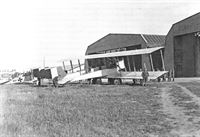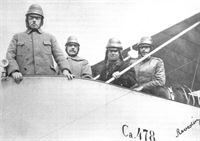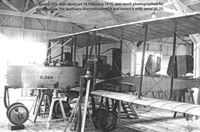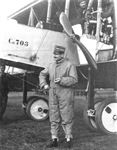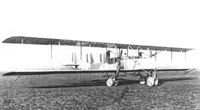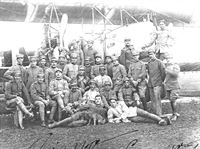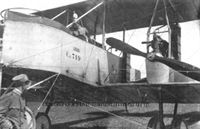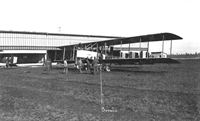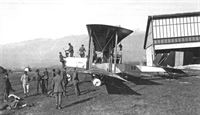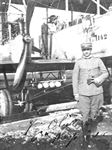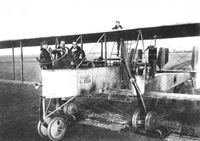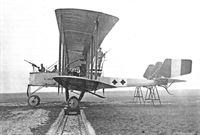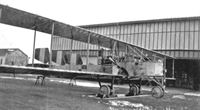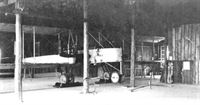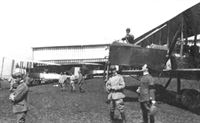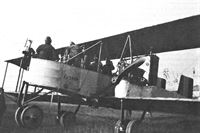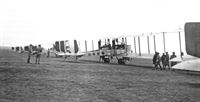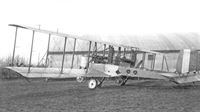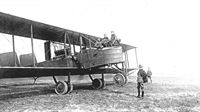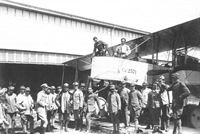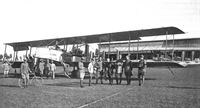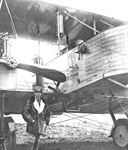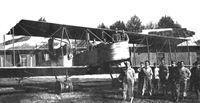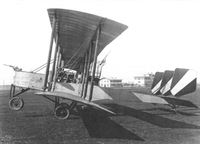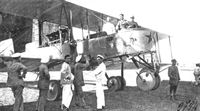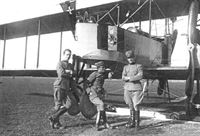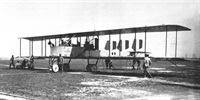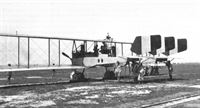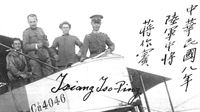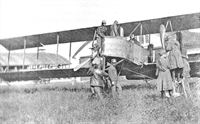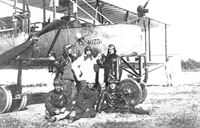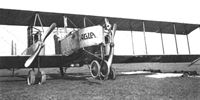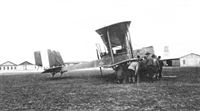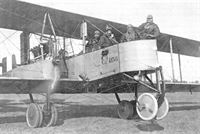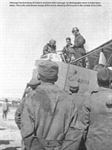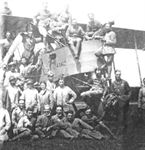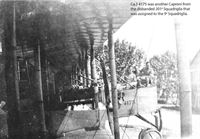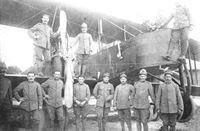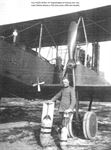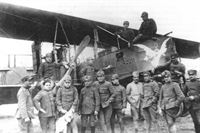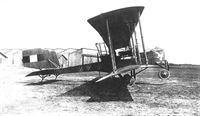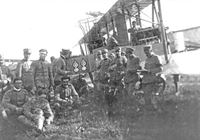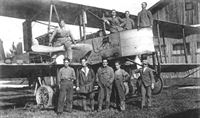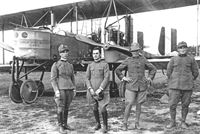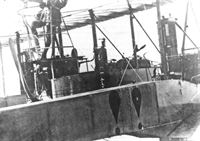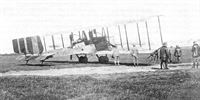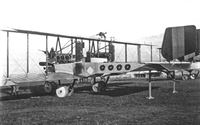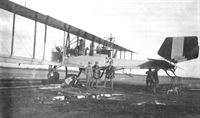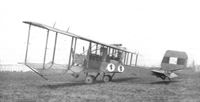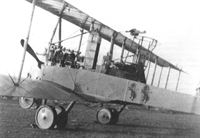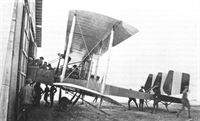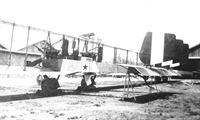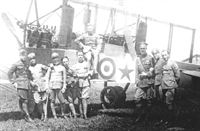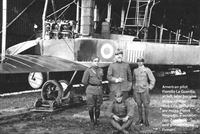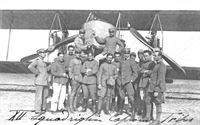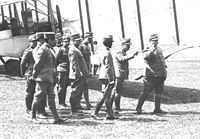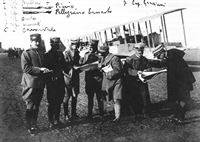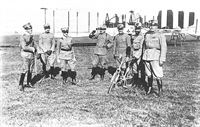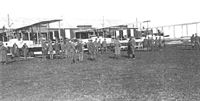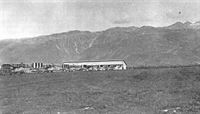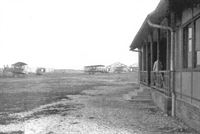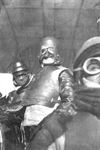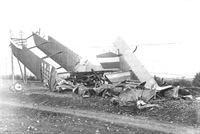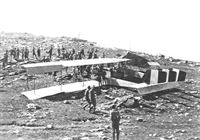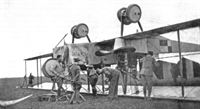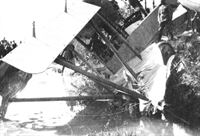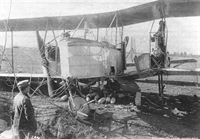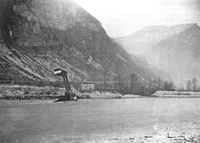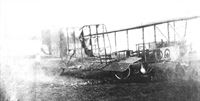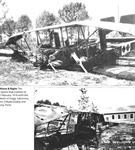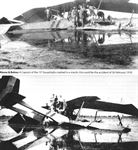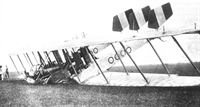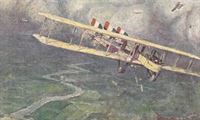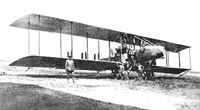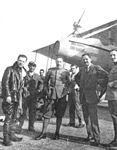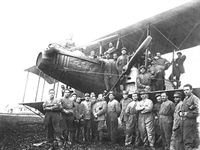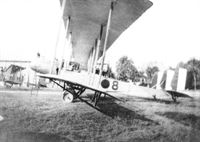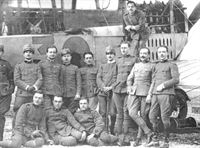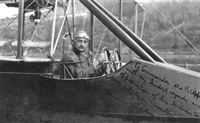Книги
Aeronaut
R.Gentilli
Italian Aviation Units in the First World War. Vol.1
294
R.Gentilli - Italian Aviation Units in the First World War. Vol.1 /Aeronaut/ (1)
Two Caproni bombers on a daylight bombing raid are intercepted By Austro-Hungarian Albatros D.III fighters.
The Austrian Lohner L.40 that fell in Italian hands and was copied by Macchi, here at Porto Corsini; behind it parts of a Borel monoplane can be seen (USMM)
A Short Type 320 armed with a torpedo, hanging from a crane at Brindisi. The raid on Cattaro on 2 September 1917 failed due to bad weather.
Cap. Alberto Livi, commander of the VIII Gruppo, with a Sopwith Camel, the type of airplane in which he lost his life.
The Austrians repaired Caproni 703, shot down on 18 February 1916, and flew it at Aspern. Here it is seen with Brandenburgs 26.41 and 26.45, still carrying the Italian colors on its rudders. (Flygvapnetmuseum)
The Caproni Ca.3 exhibited in the Historical Museum of the Italian Air Force at Vigna di Valle, actually a post-war Ca.3, 23174, was painted in 2006 as Ca 4166 of the 11a Squadriglia. Behind it is the fuselage of a Junkers J4.
The SVA was an excellent airplane, and it remained in production 8 years after the end of the war. Here are two SVA 5 supplied to the French for evaluation. (Collection S.H.A.A.)
The Ansaldo SVA 5 was the fastest aircraft in service during WWI with a top speed of 147 mph. It was the best Italian reconnaissance airplane. Despite its speed, Italian fighter pilots rejected it as a fighter due to its relative lack of maneuverability and retained the much slower Hanriot HD.1 as Italy's standard WWI fighter.
The Ansaldo SVA 5 was the fastest aircraft in service during WWI with a top speed of 147 mph. It was the best Italian reconnaissance airplane. Despite its speed, Italian fighter pilots rejected it as a fighter due to its relative lack of maneuverability and retained the much slower Hanriot HD.1 as Italy's standard WWI fighter.
A large parade was organized on 20 September 1918 at Padua airfield. Behind a first row of three Spads and six SVAs, there are Capronis with different one or two colors camouflage over the wings.
The most famous airplane of the most famous deed of the Italian Air Force in World War 1, the SVA two-seater of Palli and d'Annunzio that flew over Vienna, is preserved in the Vittoriale, d'Annunzio's mansion, now a museum and research center, on Lake Garda.
Uniforms of Italian aviators at the start of the Great War in a painting by the reputed illustrator Quinto Cenni.
The Caproni Ca.3 exhibited in the Historical Museum of the Italian Air Force at Vigna di Valle, actually a post-war Ca.3, 23174, was painted in 2006 as Ca 4166 of the 11a Squadriglia. Behind it is the fuselage of a Junkers J4.
The commander in chief of the Italian army, Gen. Cadorna, and his deputy, Gen. Porro, on 21 August 1915 flew on Ca 478 for 25 minutes with pilots Bailo and Graziani.
General Carlo Porro, deputy chief of staff of the Italian Army, is seen at left in the photo on the occasion of a much publicised flight in a Caproni.
General Carlo Porro, deputy chief of staff of the Italian Army, is seen at left in the photo on the occasion of a much publicised flight in a Caproni.
THE WAR IN THE ITALIAN SECTION. - General Cadorna (the second from the right), who has made several flights since Italy came into the war, in one of our Ally's aeroplanes which has just returned from a raid over the Austrian lines.
The Austrians repaired Caproni 703, shot down on 18 February 1916, and flew it at Aspern. Here it is seen with Brandenburgs 26.41 and 26.45, still carrying the Italian colors on its rudders. (Flygvapnetmuseum)
Caproni 703, shot down on 18 February 1916, was much photographed for propaganda, the Austrians then recovered it and tested it with serial 00.25.
Pico Deodato Cavalieri and Cola Leone De Renzis. Cavalieri, a Jew, died in training as a seaplane pilot. His family gifted their palace in Ferrara to the nation; called "Casa della Patria", it is the home to veterans' associations.
Caproni 711 over the tracks of the little carts used to move the airplanes out of the hangar at Aviano. (Collection Ferruccio Ballista)
Another view of Caproni 719; over the serial number there is the ribbon of the medal "Distintivo specials per i militari ed assimilati che sopportano le fatiche dell'attuale Guerra" (Special badge for soldiers and related personnel who endure the hardships of the current war).
Ca.1 or 300 hp 1136 of 3a Squadriglia with a white cross emblem, probably the Cross of Savoy, I a red field with a blue border.
The first "ace of clubs" of the 8a Squadriglia, Ca.1 1151.
One of Italy’s most famous bomber crews was formed by tenenti Luigi Gori and Maurizio Pagliano (pilots), capitano Aurelio Barbarisi (observer) and soldato Alessandro Zamengo (motorist-gunner). The crew, assigned to 8th squadriglia, started flying together on the Ca.300 serialled 1151 and christened “Ace of spades”. The insignia is visible in the photo.
One of Italy’s most famous bomber crews was formed by tenenti Luigi Gori and Maurizio Pagliano (pilots), capitano Aurelio Barbarisi (observer) and soldato Alessandro Zamengo (motorist-gunner). The crew, assigned to 8th squadriglia, started flying together on the Ca.300 serialled 1151 and christened “Ace of spades”. The insignia is visible in the photo.
Before being assigned to the 7a Squadriglia, Caproni 1160 was tested with a 25-mm cannon. How this gun could be operated in flight is not clear.
Mario Giulio Agostini at the controls of Caproni 1175. In this photo the Type E bombing sight can be clearly seen. (Archive Fiorenzo Longhi)
Caproni 300 hp 1183 according to documents was assigned to 6a Squadriglia, but here it carries the blue, red, and white squares, markings of 4a Squadriglia. (Archive Quelli del 72)
Caproni 1232, in an unusual dark finish, at Aviano. in the background two other Capronis of the 7a Squadriglia.
Personnel of 3a Squadriglia with Caproni 350 hp 1254. The second man from the left standing is ten. Casimiro Buttini, the fifth is magg. Falchi.
The markings for the 10a Squadriglia in 1917, yellow circles with blue borders. The airplane is probably Ca.3 2329. (Archive Roberto Bassi)
The same airplane, from another angle, showing that it carried the red flowers, insignia of the 15a Squadriglia, on the fuselages and a pennant on the central nacelle.
Ca.3 2366 was an old airplane, that was refurbished and sent to France, in dark night finish. (Archive Roberto Bassi)
A well-known photo that represents Italian aviation in the Great War: the Caproni, the most important airplane, Pagliano and Gori, two gallant pilots killed in action, and the pervasive influence of the poet d'Annunzio with his mottos: "Nulla via invia", no road is too hard, and "Repetita iuvant", it is useful to repeat. The flag with St. George is tied to the landing gear.
Federico Zapelloni in front of his Ca 2380 showing the ribbons of his decorations and the names and dates of the bombed targets. (Archive Longhi)
Without armament, Ca.3 2380 was used for liaison flights to occupied Austria in 1919. On the nacelle Vienna, Prague, and Pressbug (Bratislava) have been painted. The officer is ten. oss. Scotti Fantoni. (Archive Fiorenzo Longhi)
Ca.3 2387 of the 9a Squadriglia survived the war, here it is at Ciampino, in pristine conditions, almost ten years after its first flight.
Caproni Ca.3 2395 of the 11a Squadriglia in front of the big airship hangar at Grottaglie airfield, where Boeing 787 Dreamliner fuselages are now built.
Caproni Ca.3 2609 with pilots Gori, left, and Pagliano, right. The flags show the halberd, symbol of Trieste, and an Italian flag with St. George and the dragon, a gift of patriotic ladies.
Ca.3 4046 after the war went to Rome and was used for propaganda flights. Here it is seen with a Chinese officer. This airplane was then converted back into a bomber and served until 1925.
Caproni 4054 was used after the war for liaison flights, here it is pictured at Cheb airfield, western Czecho-Slovakia, in 1919. (Archive Jiri Railich)
Ca.3 4069 of the 14a Squadriglia armed with two 260-mm bombs, weighing 240 pounds each, and with mud guards at the wheels. (Archive Caliaro)
Ca.3 4059 (4069 ???) crashed on the night of 4 September 1917 killing all its crew.
Ca.3 4059 (4069 ???) crashed on the night of 4 September 1917 killing all its crew.
Although the bombing of Cattaro received wide coverage, no photographs seem to have been taken. This is the only known image of the event, showing d'Annunzio in the cockpit of Ca 4160.
Ca.3 4175 was another Caproni from the disabled 201a Squadriglia that was assigned to the 9a Squadriglia.
Ca.3 4218 of the 10a Squadriglia in dark night finish. The serial number is painted in very small white characters below the bomb sight.
Ca 3 4229 carried a peculiar insignia, the rank of a sergeant, as if meaning that also a NCO could command a bomber, with an eagle carrying a bomb.
Ca.3 4236 of the 14a Squadriglia, in blue-grey night finish, with three American officers. It is not known if this photo was taken in France or in Italy.
Caproni Ca.3 11495, loaded with bombs, is fitted with mudguards at the wheels. (Archive Roberto Mantiero)
Ca3 11503 passed from 6a Squadriglia to 4a Squadriglia in the last days of the war. Its Latin motto is "Unus non sufficit orbis" means"One world is not enough". Serg. Vassura is the first on the right. (Archive Caliaro)
Air-to-air photo of a Caproni of the 7a Squadriglia, in dark finish; the blue stars appear also on top of the fuselages, there are no roundels on the wings. (Archive Fiorenzo Longhi)
A Caproni showing two Exclamation marks. There was another one showing two Question marks, but to which squadron they belonged is not known.
A Caproni of the 13a Squadriglia showing the knot of Savoy, an unusual small flag on the rudder, and camouflage with wide bands on the wings and horizontal tail. (Archive Caliaro)
A Caproni Ca.3 with unusual markings, two question marks, and indeed the squadron to which it belonged is unknown. (Archive Caliaro)
The aircraft of the 4a Squadriglia were identified by having one, two, three, or four lions. (Archive SHAA)
After their mission, some Caproni visited the Foggia flying school, for the morale of the American trainees.
A Caproni Ca.3 of r Squadriglia at San Pelagio in 1918. Two Fiat machine guns are on the back turret.
American pilot Fiorello La Guardia, at left, later became mayor of New York City. With him are magg. Pietro Negrotto, a senator, cap. Zapelloni, and gunner Otello Firmani.
This unidentified Caproni, marked with collar tabs, shows ten daisies, the symbol of the 9a Squadriglia, probably meaning he number of missions it flew.
Gen. Paolo Morrone, Minister of War from April 1916 to June 1917, is shown the Capronis of 1a Squadriglia. Behind him are magg. La Polla, commander of the bomber group, and cap. Mondelli.
In front of a Caproni, the airmen of the first heavy bomber unit in the world. From the left, Laureati, Pellegrino, Carnevale, Graziani, Ercole, Barbieri, Piccio.
Ground personnel and crewmen posing at Aviano in front of a Ca.3 showing the new insignia of black lions.
Caproni 300 hp bombers taking off from Aviano in February 1916.
La Comina, near Pordenone, was the first operational Caproni base. From here sprung all the main operations of 1915-16. The photo shows the great wooden hangars built for the bombers, the defensive installations, the huge shipping crates. Construction details - notice the presence of both long and short rudders - and serials date the image to Spring 1916.
La Comina, near Pordenone, was the first operational Caproni base. From here sprung all the main operations of 1915-16. The photo shows the great wooden hangars built for the bombers, the defensive installations, the huge shipping crates. Construction details - notice the presence of both long and short rudders - and serials date the image to Spring 1916.
Caproni Ca.3 of the 3a and 7a Squadriglia of the IV Gruppo detached from La Comina - Pordenone to Aviano for a ceremony in July 1917.
Lined up for a ceremony at Aviano, July 1917, the Capronis of 3a Squadriglia and behind them those of 1a Squadriglia.
A large parade was organized on 20 September 1918 at Padua airfield. Behind a first row of three Spads and six SVAs, there are Capronis with different one or two colors camouflage over the wings.
After the tragic results of the raid of 18 February 1916, armor was tested for the Caproni airmen, but it was not adopted.
Shot down on 25 August 1916 with the death of squadron commander cap. Coniglio, Caproni 300 hp 1179 draws the attention of Austrian soldiers.
Ca.3 1197 turned over on landing on 14 May 1917 after bombing Chiapovano. At that time the unit used for identification a system of white, red, and blue squares in different combinations. (Archive Caliaro)
Austrian postcard showing Ca.3 2354 wrecked at Campoformido after a night mission on 27 October 1917.
The photo of Caproni 4062 of the 6a Squadriglia shot down on 26 October 1917 was circulated for propaganda purposes.
Caproni 4076 of Marelli and Soliani after its dramatic landing on the Adamello glacier, 25 May 1918. (Archive Quelli del 72)
The Caproni that crashed on 2 February 1918 with the death of magg. Salomone, ten. D'Ayala Godoy, and serg. Porta.
A Caproni of the 13a Squadriglia crashed in a marsh, this could be the accident of 26 February 1918.
Two Caproni bombers on a daylight bombing raid are intercepted By Austro-Hungarian Albatros D.III fighters.
Ten. Amerigo Contini, a Caproni pilot and an artist, drew very realistic paintings of bombers in action, that were used for postcards.
Ca.5 11585 on 17 June, after landing at Villaverla, British personnel greet the Italian crew, and on the ground there are the bombs that fell on the airfield. The British, northern Italy being considered part of the Near East, are wearing pith helmets. (Archive Caliaro)
The special crew that flew the first combat mission of a Caproni Ca.5 11585: at the center t.col. Armani, first on the left cap. Palotta, and last ten. Ridolfi.
Ca.5 11624 was assigned to the 14a Squadriglia, but did not fly on operations. (Archive Longhi - Mario Chirico)
Edoardo Barbiroglio, later a pilot with the 112a Squadriglia, in training with a Gabardini powered by a tiny Anzani engine.
The Macchi Parasol was the first airplane of Italian design in service, but it was unstable and dangerous, and was soon retired.
A factory shot of the first build example.
A factory shot of the first build example.
Macchi Parasol of the 2a Squadriglia Artiglieria at Medeuzza. The rudder now carries the national colors, but the Savoy eagle has been preserved. (Archive Longhi)
The airmen after the successful raid at Punta Semana, TV Roberti, cap. De Rada, STV Caffaratti, and cap. Pesci.
The Macchi L.3 flew better but floated worse than the FBA, and was built in smaller numbers, just 203. This is 3425 in Venice.
One of the first Macchi MM of the first production batch of ten, 4873, at Varese, in the cockpit is Macchi test pilot Giacomo Reggiori who died in a test flight on this aircraft on 19 July 1917.
Nieuport 11s of the 80a Squadriglia and SP.2 of the 23a Squadriglia, I Gruppo. This line-up of aircraft is not for operations, but for some sort of ceremony.
The crowded airfield at Casoni in December 1917, the base for Pomilios of the II Gruppo and Hanriots of the VI Gruppo.
This SP3, 4648, was shot down on 16 July 1917 by the Austrian pilot Kadetz of Flik 23/D, but research in the Italian archives has failed to find details on this event, proving that confirmation of legitimate claims is not always possible.
Regia Nave Elba was the first seaplane tender of the Regia Marina, here entering the harbor of Taranto, with a Curtiss flying boat on its deck.
Bleriot 283 of the 3a Squadriglia, on the rudder the national colors have been painted, but the black eagle has been retained.
A Bleriot of the 1a Squadriglia showing the first national marking, a black circle. The first pilot from the left is ten. Ettore Croce. (Archive Caliaro)
Bleriot 286 of the 2" Squadriglia showing the national markings in use in the first weeks of the war.
Bleriot 300, probably used for training after service with the 1a Squadriglia, now with the national colors of green, white, and red on the rudder. (Archive Schifano)
Young ladies visiting the 1a Squadriglia in the first days of the war. On the rudder the Bleriots show the national insignia, an eagle with the shield of Savoy, introduced in April 1913.
A Bleriot of the 3a Squadriglia has smashed its landing gear. On the rudder there is the black eagle, and the black circle and bar on the wing confirm that this is a wartime photo.
Medeuzza airfield, with a Caudron G.3 in the background; the bid arrow was used to show the direction of the wing to the pilots.
The Caudron G.3s of the 1a Squadriglia Artiglieria being prepared for action at the airfield of La Comina, Pordenone.
Austrian servicemen posing with the brand new Caudron G.3 507 which a confused pilot had brought to them.
The FBA, license built from France, was the backbone of Italian naval aviation, over 1,000 were produced by six factories, and it was even put back in production after the war. This one, 3181, is at Brindisi in the first half of 1916.
Supplied by France and license-built in Italy, the Hanriot Hd.1 was successful and much liked. This is Hd.1 19309 painted as French 515 with the colors of ace Baracchini in the Italian Air Force Museum at Vigna di Valle, near Rome.
The crowded airfield at Casoni in December 1917, the base for Pomilios of the II Gruppo and Hanriots of the VI Gruppo.
A Farman of the 12a Squadriglia in the first days of the war, still with the black circle and bar markings. (Archive Caliaro)
An early production Farman model 1914, or Farman MF, with the first type of national insignia, an eagle with the shield of Savoy on the rudders.
Farman 268 of the 9a Squadriglia, a cage is attached to catch the cartridge cases of the machine gun.
Gabriele d'Annunzio and cap. Beltramo after their flight over Trento on 20 September 1915. (Archive Caliaro)
Farman 539 of the 9a Squadriglia showing the fins faired with cloth, and camouflage paint applied to the horizontal tail and to the top wing. (Archive Caliaro)
Farman 802 if the 12a Squadriglia in a photo signed by gunner Battaglini (possibly Cesare Battaglini, later a SVA pilot). (Archive Caliaro)
Personnel of the 4a Squadriglia with Farman 901, in the background the harsh mountains of the Carnia region. (Archive Caliaro)
A Farman of the 4a Squadriglia with Antonio Locatelli, a young pilot who became one of Italy's most important aviators.
A Farman of the 10a Squadriglia with a pipe projecting from the nacelle, possibly a device to drop bombs.
The Farman that crashed on 7 April 1916, killing ten. Martinelli, after combat with Austrian Brandenburgs.
Cap. Piccio, standing, with a Nieuport Monoplane of the 5a Squadriglia, the war marking of bar and circle are painted white on the darker wings of the Nieuport. The man in the cockpit is ten. Ercole Messi.
Nieuport monoplane 111 of the 6a Squadriglia showing the black bar national marking on its wing. (Archive Giorgio Catellani)
Ten. Calori in front of a Nieuport, in the cockpit is cap. Pier Ruggero Piccio, future ace and commander of the Italian Air Force.
Domenico Mondelli with a Nieuport Monoplane. After being transferred to infantry, in August 1917 he was the only Italian officer to enter Castagnevizza during the 11th Battle of the Isonzo.
Cap. Oreste Salomons, here in front of a Nieuport 10, was the first Italian airman to be awarded the Gold Medal for Valor.
Nieuport 10 #1037 armed with a Colt gun over the top wing and another unidentified gun on the side of the cockpit. The second airman is cap. Tacchini, commander of the 8a Squadriglia, the third one is ten. Baracca.
Nieuport 11s of the 80a Squadriglia and SP.2 of the 23a Squadriglia, I Gruppo. This line-up of aircraft is not for operations, but for some sort of ceremony.
A large parade was organized on 20 September 1918 at Padua airfield. Behind a first row of three Spads and six SVAs, there are Capronis with different one or two colors camouflage over the wings.
Voisin 378 in marked "XVIa Squadriglia" but when this unit became operational it was named 5a Squadriglia.
Voisin 380 of the 5a Squadriglia, unarmed but with a tube for dropping bombs, a device that disappeared quickly. (Archive Salvo Di Marco)
Voisin 3 V.589 of the 7a Squadriglia being prepared for a mission, soldiers are attaching fins to a 162-mm bomb. (Archive Caliaro)
The same Voisin 589 ready to fly; a Fiat 1914 machine gun is fitted on the front tripod. (Archive Caliaro)
Voisin 608, here still in the field of its manufacturer, SIT in Turin, was assigned to the 7a Squadriglia, on its fuselage the construction number, 143, is marked with chalk.





